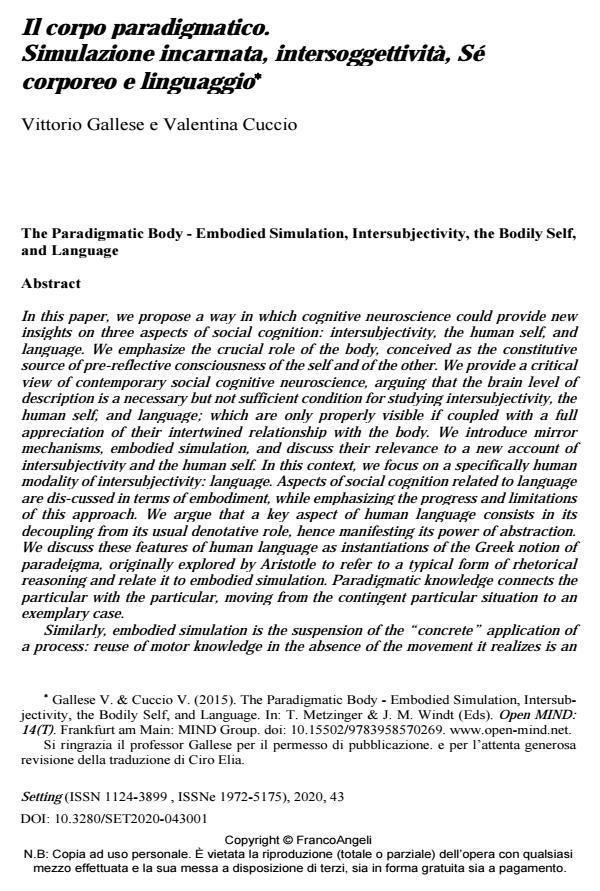The Paradigmatic Body - Embodied Simulation, Intersubjectivity, the Bodily Self, and Language
Journal title SETTING
Author/s Vittorio Gallese, Valentina Cuccio
Publishing Year 2020 Issue 2020/43
Language Italian Pages 40 P. 5-44 File size 399 KB
DOI 10.3280/SET2020-043001
DOI is like a bar code for intellectual property: to have more infomation
click here
Below, you can see the article first page
If you want to buy this article in PDF format, you can do it, following the instructions to buy download credits

FrancoAngeli is member of Publishers International Linking Association, Inc (PILA), a not-for-profit association which run the CrossRef service enabling links to and from online scholarly content.
In this paper, we propose a way in which cognitive neuroscience could provide new insights on three aspects of social cognition: intersubjectivity, the human self, and language. We emphasize the crucial role of the body, conceived as the constitutive source of pre-reflective consciousness of the self and of the other. We provide a critical view of contemporary social cognitive neuroscience, arguing that the brain level of description is a necessary but not sufficient condition for studying intersubjectivity, the human self, and language; which are only properly visible if coupled with a full appreciation of their intertwined relationship with the body. We introduce mirror mechanisms, embodied simulation, and discuss their relevance to a new account of intersubjectivity and the human self. In this context, we focus on a specifically human modality of intersubjectivity: language. Aspects of social cognition related to language are dis-cussed in terms of embodiment, while emphasizing the progress and limitations of this approach. We argue that a key aspect of human language consists in its decoupling from its usual denotative role, hence manifesting its power of abstraction. We discuss these features of human language as instantiations of the Greek notion of paradeigma, originally explored by Aristotle to refer to a typical form of rhetorical reasoning and relate it to embodied simulation. Paradigmatic knowledge connects the particular with the particular, moving from the contingent particular situation to an exemplary case. Similarly, embodied simulation is the suspension of the "concrete" application of a process: reuse of motor knowledge in the absence of the movement it realizes is an example of paradigmatic knowledge.This new epistemological approach to intersubjectivity generates predictions about the intrinsic functional nature of our social cognitive operations, cutting across, and not subordinated to, a specific ontology of mind.
Keywords: Cognitive neuroscience, Embodied simulation, Intersubjectivity, Language, Mirror neurons, Paradigm, Social cognition.
Vittorio Gallese, Valentina Cuccio, Il corpo paradigmatico. Simulazione incarnata, intersoggettività, Sé corporeo e linguaggio in "SETTING" 43/2020, pp 5-44, DOI: 10.3280/SET2020-043001